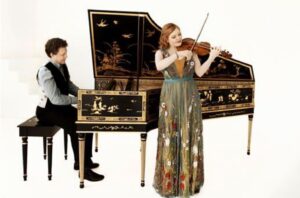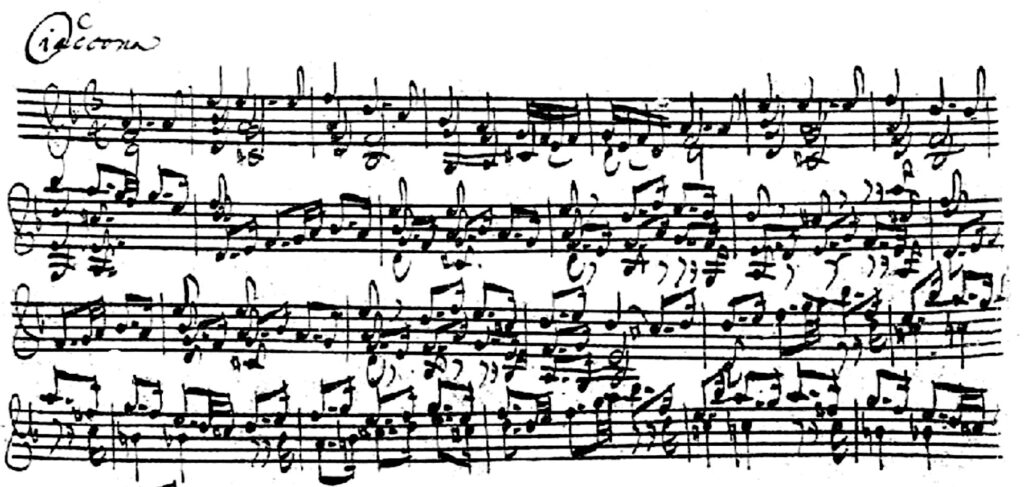SFEMS’s regular concert series comes to a powerful conclusion the weekend of March 20–22 in a program of both virtuosity and depth. We will be treated to a joint appearance by two giants of their generation, violinist Rachel Barton Pine and harpsichordist Jory Vinikour, who are among the finest current exponents of their instruments. They will perform a program devoted to the music of Johann Sebastian Bach, including two of the composer’s sonatas for violin and harpsichord, which the duo recorded in 2017 for the Cedille label, as well as the great D-minor Partita for Solo Violin, BWV 1004, and the Ouvertüre nach Französischer Art (French Overture—Partita in B minor for solo harpsichord), BWV 831. The artists contributed these notes on the music they will perform.
* * *
 Johann Sebastian Bach’s six sonatas for violin with harpsichord obbligato (BWV 1014–1019) were likely composed during Bach’s period in Cöthen, between 1717–1723. Bach’s son, Carl Philipp Emanuel describes these works as among the finest his father composed. The idea of juxtaposing a thorough-composed harpsichord part against the “solo” instrument was quite novel at this time, the harpsichord possessing a tremendous solo repertoire, but used principally as a continuo instrument in ensembles. Apart from the concerti for harpsichord and strings, Bach used the harpsichord as an equal duo partner in three sonatas with viola da gamba, at least two with flute, and the six sonatas with violin.
Johann Sebastian Bach’s six sonatas for violin with harpsichord obbligato (BWV 1014–1019) were likely composed during Bach’s period in Cöthen, between 1717–1723. Bach’s son, Carl Philipp Emanuel describes these works as among the finest his father composed. The idea of juxtaposing a thorough-composed harpsichord part against the “solo” instrument was quite novel at this time, the harpsichord possessing a tremendous solo repertoire, but used principally as a continuo instrument in ensembles. Apart from the concerti for harpsichord and strings, Bach used the harpsichord as an equal duo partner in three sonatas with viola da gamba, at least two with flute, and the six sonatas with violin.
These works, though never published in Bach’s lifetime, were admired by Bach’s followers, and copies circulated throughout Europe.
Carl Philipp describes these works as trio sonatas, much in line with the trio sonatas for organ. That is to say, the violin and the two hands of the harpsichord part each represent relatively equal polyphonic lines within this three-part framework. That said, the sonatas vary tremendously in character, and even in texture, Bach treating both instruments in a profoundly idiomatic fashion.
As a case in point, the sonata in B Minor, BWV 1014, begins with a highly expressive adagio. The violin’s florid cantilena is accompanied by a steady eight-note accompaniment from the harpsichord, with the right hand’s two voices mostly playing thirds or sixths, although frequently forming two independent voices. When one considers that the violin is also frequently playing double-stops, this brings the movement to a five-part texture. The second movement is a fairly straight-forward fugue, in a true trio sonata texture. The third movement, in D Major, is a serene andante, the violin and the right hand of the harpsichord embroidering over a steady eight-note bass line. The brilliant finale again shows the violin and the two hands of the harpsichord in a three-part contrapuntal texture.
Sei Solo A Violino Senza Basso Accompagnato (Bach’s Six Sonatas and Partitas for Violin Alone) The Six Sonatas and Partitas by Johann Sebastian Bach are the culmination of an almost-century-old tradition of multiple-voice writing for unaccompanied violin in Germany. Works by Thomas Baltzar (Preludes, Allemande, etc.), Heinrich Ignaz Franz von Biber (Passacaglia), Johann Paul von Westhoff (Suites), and Georg Pisendel (Sonata) serve as significant prior examples of this improvisatory and compositional practice with which Bach was intimately familiar.
Bach’s autograph manuscript from Cöthen is dated 1720, though some scholars believe he may have begun writing the Sonatas and Partitas as early as 1717. The title page includes the designation “Part 1,” with Part 2 being the Six Suites for unaccompanied ‘cello (probably the “da spalla” type of violoncello played by himself).
The Sonatas and Partitas are full of technical challenges that must be overcome in order to bring out the harmonies and polyphonies. They require a highly refined technique of both the left and right hand. Clearly Bach was not only a genius composer and master keyboard player, but also a violin virtuoso of the first rank. The violin was most likely the first instrument he studied with his violinist father, Johann Ambrosius. His first professional jobs in Lüneberg and Weimar included significant duties as a violin player and he continued to play the instrument for all of his life. Perhaps his esteem for the violin is reflected in the fact that the longest fugue he ever wrote was not for organ, harpsichord, or ensemble, but for unaccompanied violin (the Fuga of BWV 1005).
The internal symmetry of the six violin works points to his conception of them as a cycle, rather than merely a collection. Each Fuga is increasingly longer and more complex. In contrast, the third movements of the Sonatas become ever sparer, from three voices to two to primarily one. The Partitas increase in size from four movements to five to six. Their stylistic language follows a forward path, from the proto–17th Century of the B Minor to the High Baroque Italian of the D Minor to the new modern French style of the E Major.
The Partitas are suites of dance movements. Bach follows the standard Italianate sequence of Allemande, Corrente, Sarabande, Gigue in his D Minor Partita, but deviates from it in the last movement of the B Minor, substituting an intriguingly titled Tempo di Borea. (Perhaps this was a nod to Pisendel whose earlier sonata had concluded with a Giga and Variation.) Despite the fact that none of these dances were meant to accompany actual dancing, Bach is often meticulous in his adherence to symmetrical phrases indicating regular step units.
The first four movements of the Partita in D Minor could form a suite of their own, but it turns out that they are leading up to one of the pinnacles of all music. Much has been written about the Ciaconna as a monumental showpiece, or as a journey through the deepest of emotions. The theory that Bach wrote it as a memorial to his first wife has been convincingly debunked, but we still continue to hope that perhaps it has some hidden, poignant extra-musical meaning such as the crucifixion. (Another theory suggests that the three sonata-partita pairs may represent birth, death, and resurrection.) Yet the music need not justify itself beyond its notes and the emotions they portray. These thirty-four imaginative variations in three sections are grand, playful, peaceful, uncertain, triumphant, tragic. Yet, somehow, Bach never loses the spirit of the dance. (Rachel Barton Pine)

Ouvertüre nach Französischer Art (French Overture—Partita in B Minor), BWV 831 The so-called French Overture, originally titled Overtüre nach Französicher Art (Overture in the French style) was published in 1735, as the second work (following the Italian Concerto) of the second Clavier-Übung. These two works certainly seek to explore national styles, using the harpsichord in an orchestral fashion to emulate French and Italian traits. However, the French Overture, which Bach initially composed (although unpublished) in C Minor, serves to complete the sequence of tonalities of the six partitas for solo harpsichord, BWV 825–830 (published from 1726–1730 as the first volume of the Clavier-Übung).
The first movement, whence Bach draws the heading title of the work, is indeed an Overture, inspired by the early models of Lully. In Bach’s keyboard works, we find this type of movement in the D Major Partita, BWV 828, as well as opening the second half of the Goldberg Variations. The first half of all of these pieces is always in duple time, with dotted rhythms. Whereas in the D Major partita, and the 16th of the Goldberg Variations, the effect is jubilant, here, the mood is dramatic, even tragic. This opening section is followed by an extended fugal passage in 6/8, in distinctly delineated episodes. Bach notes the changes of keyboard with forte (lower keyboard) and piano (upper). At the end of this fugue, the opening material returns, bringing this extraordinary movement to a close.
Bach skips the customary allemande, following the overture with an elegant courante, strongly inspired by François Couperin’s models. A lively gavotte, which Bach marks forte alternates with a much more intimate (piano) gavotte in D Major. In this second gavotte, Bach writes this as a two-part piece, perhaps evoking a duet between oboe and bassoon. Likewise, the rather explosive first Passepied alternates with a crystalline B Major trio. Even the exquisitely introspective Sarabande is written in strict four-part counterpoint. The first of the Bourées is of a very rustic character. It alternates with a more flowing piece, also in B Minor. The gigue is very much in the mold of examples by the French composers who Bach so admired: Couperin, Marchand, etc. The suite concludes with an Echo—this rustic dance uses once more the contrasts of the harpsichords two keyboards, creating the effect that the title suggests. (Jory Vinikour)
Sonata No. 3 in E Major for Violin and Harpsichord, BWV 1016 The sonata in E Major, BWV 1016, opens with a monumental adagio. Over a thickly layered, choral-like accompaniment in the harpsichord, the violin soars freely in a richly ornamented line. This is followed by a merry fugue. The third movement, Adagio ma non tanto, shows the two instruments exchanging expressive tripletted figuration and chordal accompaniment. The final movement, a brilliant, concerto-like allegro, features the violin and harpsichord exchanging brilliant, swirling, sixteenth note figuration. The middle section of the movement juxtaposes a development of this writing with contrasting triplet material, creating an unusual “two against three” rhythmic texture. (Jory Vinikour)
* * *
SFEMS presents Rachel Barton Pine and Jory Vinikour at 8:00 p.m., Friday, March 20, at First Presbyterian Church, 1140 Cowper Street at Lincoln, in Palo Alto; 7:30 p.m. Saturday, March 21, at St. John’s Presbyterian Church, 2727 College Avenue, in Berkeley; and 4:00 p.m. Sunday, March 22, at Church of the Advent, 261 Fell Street, in San Francisco. Tickets may be purchased online, through the SFEMS box office at 510-528-1725, or at the door 45 minutes before each performance.












